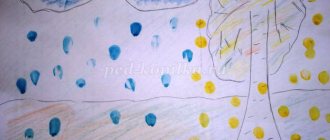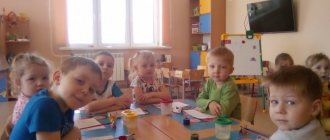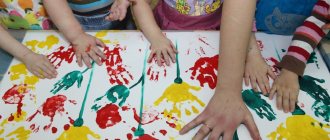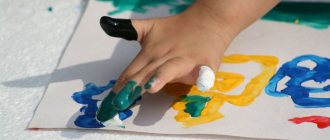Summary of a lesson on unconventional drawing in the second junior group on the topic “Rain”
Summary of the organization of continuous educational activities of children in the second junior group on the topic: Non-traditional drawing with cotton swabs and poking “Rain”
Description of the material: This summary will be of interest to preschool teachers and parents. Intended for use in the second junior group. Can be used as an introduction to the technique of drawing with cotton swabs using the poking method. Goal: Development of artistic creativity in children and activation of creative potential through non-traditional drawing techniques. Objectives of the priority area “Artistic and aesthetic development” - Introduce children to a new technique of creative activity - drawing with cotton swabs - Form creative thinking, sustainable interest in artistic activity - Develop artistic taste, spatial imagination. — To develop the skills and abilities necessary to create creative works. — Develop a desire to experiment, showing vivid cognitive feelings: surprise, doubt, joy from learning new things. Educational objectives in the integration of educational areas “Speech development”: - develop activity in a conversation with a teacher (conversation based on the fairy tale by V. Suteev “Under the Mushroom”)
- develop the ability to hear and understand the question asked
(guessing a riddle, conversation based on the fairy tale by V. Suteev “Under the Mushroom”) mushroom")
- develop the ability to establish simple connections between objects and phenomena
(the mushroom grew because it rained)
- enrich children's vocabulary with adjectives
(small, huge)
and nouns
(rain)
.
“Artistic and aesthetic development”
(musical perception) :
- development of emotional responsiveness - accumulation of musical and auditory experience in children (listening to an audio recording of “Rain” by A. Vivaldi (from the series “Seasons” - a classic for kids) - arouse and maintain interest to music, manifestations of emotional responsiveness, - to cultivate aesthetic feelings
"Physical development" - development of fine motor skills of the hand (drawing with cotton swabs, finger gymnastics "Rain") - help relieve muscle tension (finger gymnastics "Rain") - development of coordination of movements, consolidation of skills run without bumping into each other, strengthening the ability to act on a signal from an adult (p/i “Sun and Rain”) “Social and communicative development” - the ability to interact with each other, with the teacher (p/i “Sun and Rain”); conversation based on the fairy tale by V. Suteev “Under the Mushroom”) - introduction to elementary generally accepted norms and rules of relationships with peers and adults
Planned results of ECD The child is familiar with a new technique of creative activity - drawing with cotton swabs, shows independence in artistic activity; actively interacts with peers and adults; shows curiosity; has basic understanding of the environment; speaks oral language, can use speech to construct a speech utterance in a communication situation; the child can follow rules in different activities; The child has developed gross and fine motor skills, he is mobile, masters basic movements, and can control and manage his movements. Prerequisites for UUD Communicative – the ability to listen and answer questions, seek help from an adult, express gratitude, participate in joint activities; cognitive – the ability to work according to a given algorithm; regulatory – the ability to carry out actions according to a model and a given rule; the ability to listen to an adult and follow his instructions Equipment used 1. A sheet of white A4 paper with a drawn cloud and a small mushroom for each child. 2. Blue gouache in rosettes for each child. 3. Cotton swabs for each child. 4. Napkins for each child. 5. Umbrella for playing. 6. Illustrations (illustration of an ant, illustrations for V. Suteev’s fairy tale “Under the Mushroom”)
7. Audio recording of “Rain” by A. Vivaldi
(from the series “The Seasons” - a classic for kids)
, audio recording of the game “Sun and Rain”
Preliminary work Reading V. Suteev’s fairy tale “Under the Mushroom” Learning finger exercises “Rain” Rain, rain, more fun (I shake the water from my hands)
Drip, drip, don’t be sorry!
Just don't kill us! (they shake their finger)
Don’t knock on the window in vain
(knock on the window)
Better drip on the mushrooms,
(palms down)
So that they grow!
(hands are raised up)
Progress of the lesson
Introductory stage 2 minutes Goal: creating a positive attitude, motivating children for educational activities, promoting the development of movements during the game.
Guys, look how beautiful it is here.
Today we will draw, but first guess the riddle: From a cloud, like from a sieve, Drop by drop, water drips! Right! Rain! Guys, let's play a game called “Sunshine and Rain” (to music)
.
— The sun is shining brightly, the birds are singing, the children are walking. - “Rain!” - children run and hide under an umbrella. - "Sun!" the umbrella closes - the children are “walking”. - Rain! the guys run under the umbrella again. - The sun is shining! Children are “walking” - So our game is over. Sit down at the tables, guys. Main stage 11 minutes Purpose: to introduce children to a new technique of creative activity - drawing with cotton swabs; formation of skills and abilities necessary to create creative works. Practical activities for children. Conversation Guys, who can say what kind of rain it is? The rain can be strong and light. - Remember, you and I read a fairy tale about rain and fungus? — It started raining and almost got you wet? - That's right, an ant. Today an ant came to visit us. Probably the same one that was hiding under the mushroom. - Let's remember the story about the ant: - It began to rain, and where did the ant hide? -What kind of fungus was it? This is how small the mushroom was at first (points to an illustration of a fairy tale on a magnetic board)
- And then what happened?
- Who asked the ant to treat the fungus? - And everyone fit under the little mushroom? - And why? -What did he become? - That's right, big! The fungus has become huge! - Guys, look at your leaves, what do you see there? - What fungus? — What needs to be done to make our mushrooms grow? - Guys, today we will paint not with a brush, but... with cotton swabs like this (shows)
.
Explanation of the method of drawing with cotton swabs. (The teacher shows how to dip a stick in gouache and use the “poke” method to draw rain.)
- Look, I dip the stick in paint and take one small step, raise my hand, take another step next to it, and another one next to it
(Top-top-top)
.
I apply it, tear off my hand, apply it, tear off my hand, and so on until the very bottom, to the very ground. “Now you and I will draw, but first, let’s stretch our fingers.” Finger gymnastics “Rain” Rain, rain, more fun Drip, drip, don’t be sorry! Just don't kill us! Don’t knock on the window in vain. Better drop it on the mushrooms so that they grow! Practical activity - And now, guys, I will give you sticks, and you can draw rain on your pieces of paper. - Do you remember how to draw? (the teacher reminds us of the drawing algorithm)
- Guys, sit down correctly, straighten your backs and let's draw. A sheet with a mushroom and a cloud for each child:
Drawing Algorithm Explanation
Drawing that might come out
The teacher monitors the completion of the task and helps the children. The teacher introduces a new noun “rain”. While the work is being done, the music of A. Vivaldi “Rain” is played. Final stage 2 minutes Goal: to help relieve emotional and mental stress and increase the emotional mood of students. Children receiving positive assessment of their activities. The teacher sums up the educational work and gives a positive assessment to each student.
All work is posted on the board. - Look how beautiful the rain is for ...
(children's names)
, and for ...
(children's names)
the rain is heavy - a real downpour, mushrooms will grow quickly from such rain!
Well done! — Did you like drawing with cotton swabs? - Now you can paint with both a brush and a cotton swab. - Thank you for helping the mushrooms start growing. - The ant says thank you and goodbye. Application:
We recommend watching:
Drawing lesson in the preparatory group. In the winter park Advice for parents of young artists Cats. Drawing lesson for children Application for March 8th for the senior group of kindergarten
Similar articles:
How to develop your child's creativity
Abstract of GCD on communication and mathematical development in the second junior group
Preview:
Summary of a drawing lesson in the younger group
Educator: Kurkina N.S..
Educational area: “Artistic and aesthetic development”, “Cognitive development”, “Physical development”.
Goal: Create conditions for the development of creative abilities. To form the cognitive activity of children.
1. Cultivate interest in drawing.
2. Teach children to draw smooth short lines using a brush.
3. Learn to convey in a drawing the impression of life around you. To consolidate children's knowledge about the characteristic features of spring weather.
4. Learn to recognize and correctly name the color blue, develop a sense of color and rhythm, aesthetic perception and the desire to draw.
6. Cultivate neatness.
7. Give children a basic understanding of the purpose of an umbrella.
Materials: Gouache (blue), thin brushes, sippy jars, a napkin, a sheet of paper with an image of an umbrella under a spring cloud, an umbrella for playing, an easel, cards with images of various items of clothing.
Preliminary work: Conversation about seasonal natural phenomena, looking at plot pictures with rain, game “Rain and Sun”.
The teacher calls the children to him and, opening an umbrella over himself, reads a poem:
It's raining, it's raining, it's pouring down,
Get the little kids wet.
Let's quickly open the umbrella,
Let's protect ourselves from the rain.
Children's answers: About the rain.
Educator: Spring has come. And with its onset spring rains come to us. It’s not so cold in the yard anymore, but it’s not good to get wet in the rain! What things will be useful to us so that we don’t get wet?
The teacher invites the children to select the necessary pictures located on the table and place them on the easel.
Children show: Jacket, rubber boots, umbrella.
Educator: Guys, what will help us hide from the rain?
Children's answers: Umbrella.
Educator: That's right, an umbrella!
Next, the teacher, together with the children, examines different umbrellas - for children and adults.
Educator: Umbrellas come in different sizes and different colors. They are made of a special material that does not allow water to pass through. To prevent water from collecting on it, but rolling off, the upper part of the umbrella has a streamlined, rounded shape, and we hold it with a handle.
The teacher addresses the children: We already have an umbrella, so I suggest you play the game “Sun and Rain.”
The outdoor game “Sun and Rain” is played.
Educator: Guys, did you like the game?
After the game, the teacher invites the children to sit down.
Next, the teacher addresses the children: Today I will teach you how to draw rain using a thin brush. The teacher explains in detail the sequence of painting with gouache paints. Children watch the actions of the teacher.
Educator: First, you should dip the brush in water, then in blue paint and attach it to the paper, hold the sheet of paper with your helping hand and draw raindrops. The teacher accompanies the rhythm of drawing droplets with a drawn-out ri. Then the teacher invites the children to draw rain “like mine.” Children do it on their own. The teacher individually helps those children who have difficulties. Encourages children to follow the rhythm of the ri prints. During the entire lesson, the teacher monitors the children’s posture and the correctness of drawing techniques. If necessary, the teacher takes the child's hand in his own and draws several lines together.
Children look at their drawings, the teacher praises the children for their work and reads a poem to the children by G. Verd
There were clouds in the sky,
But we took an umbrella with us.
We are not afraid one bit.
At the end of drawing, the teacher places the children’s work in the creativity corner.
Source





